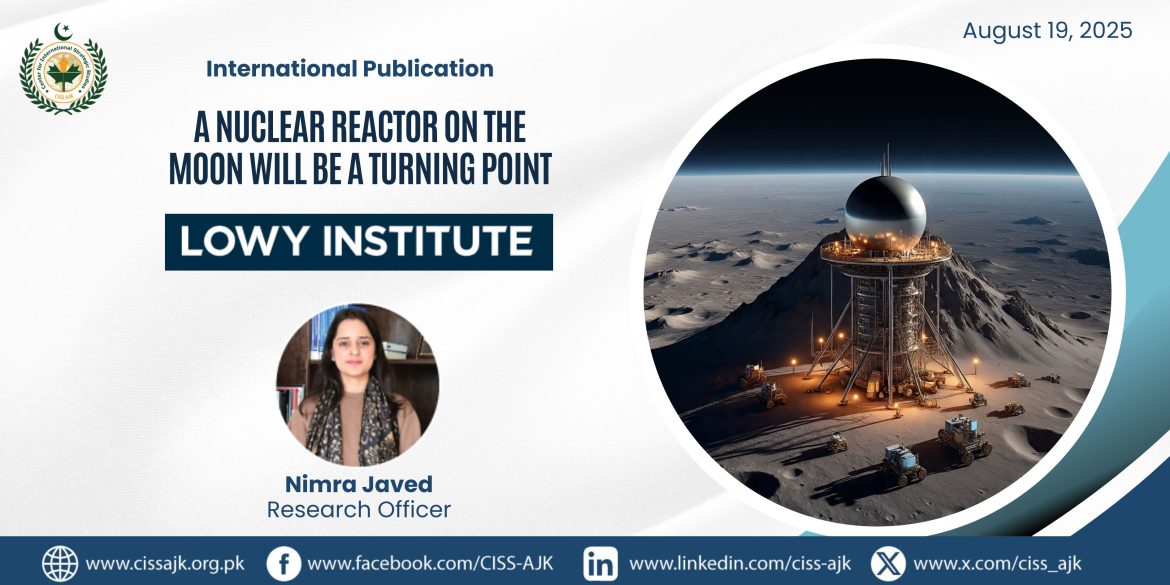Competing visions for lunar governance are dividing Washington and Beijing as nuclear technology enables permanent space-based mining and manufacturing operations.
NASA reportedly wants to fast-track by 2030 a plan to deploy a nuclear reactor on the Moon. This followed China’s earlier declaration a similar goal for 2035. These moves, aligned with NASA’s Artemis-II and China’s lunar lander test, reflect a deeper shift – from one-off landings to permanent infrastructure. This transformation is powered by converging technologies: nuclear reactors, autonomous mining, and additive manufacturing. Together, they make sustained lunar presence not just possible, but inevitable.
At the core is the nuclear reactor, which will enable 3D printers, robotic excavators, and platforms that require continuous power. Without it, no long-term system can function. Once energy is assured, lunar operations – construction, maintenance, and habitation – can proceed without constant Earth-based resupply.
Both the United States and China have made huge strides in 3D printing technology in recent years, which deployed on the Moon would reduce reliance on Earth-based materials. Mining tech is advancing just as fast. US startup Interlune, backed by NASA, is building an autonomous system to process 100 metric tonnes of lunar soil per hour. Their target is helium-3, a rare isotope for fusion energy – already reserved by two customers. China has unveiled a six-legged lunar mining robot and is developing a magnetic launch system to send materials into orbit, cutting costs and enabling a steady supply chain.
Access may be shaped not by global rules, but by who gets there first.
These technologies reinforce each other. Continuous energy powers autonomous mining. Mining feeds material processing. Processing enables manufacturing. Manufacturing replicates power infrastructure. A 2023 International Atomic Energy Agency brief notes that “advanced manufacturing techniques will play a vital role in enabling future modular reactors.” While enriched uranium and alloys still need to be shipped from Earth, the Moon offers silicon, aluminium, and iron – suitable for structures and shielding. A hybrid model may emerge: core parts from Earth, outer structures made on-site. What’s emerging isn’t just energy – it’s the basis for a scalable lunar economy.
These capabilities point to permanent human operations in space. With stable energy, automated labour, and on-site production, the Moon can evolve from research outpost to logistics hub. The implications are strategic. The first nation to build lasting infrastructure will shape the rhythm of lunar activity. Missions are no longer about testing, they’re about continuity and control.
esource access is central. The Moon holds over a million tons of helium-3, largely absent on Earth but abundant due to solar wind exposure. Fusion reactors using helium-3 could deliver clean energy with minimal radioactive waste, offering a major edge to early access nations. The Moon also contains rare earth elements vital for semiconductors, clean tech, and defence. The US Geological Survey notes that 70% of Earth’s current rare earth production comes from China. Lunar alternatives could reshape or reinforce global supply chains.
Lunar infrastructure becomes political and economic leverage. The ability to mine, refine, and use materials on-site gives early actors a commanding edge. As this capacity grows, access may be shaped not by global rules, but by who gets there first.
This urgency reveals a legal vacuum. The 1967 Outer Space Treaty bans national appropriation but says little about long-term operations, resource rights, or exclusion zones. In 2015, the United States passed the Commercial Space Launch Competitiveness Act, granting private firms rights to extract and own space resources. As Senator Ted Cruz explained, “You don’t own the ocean, but you can own the fish you catch.” The Artemis Accords, signed by 56+ countries, extend this principle. They emphasise peaceful use and transparency – but also introduce “safety zones” to prevent interference.
NASA’s Mike Gold says these zones are “not about ownership; they’re about transparency and deconfliction.” Yet the language is vague. Terms like “reasonable” and “nominal” lack precision and are open to misuse.
China, not part of the Artemis Accords, supports a different vision. Its official documents describe the Moon as “the common wealth of all humanity” and promote UN-based governance. Yet it’s also moving forward with establishing the International Lunar Research Station in partnership with Russia, offering a parallel system: cooperative in language, competitive in practice.
Bridging this gap is slow. The UN’s Committee on the Peaceful Uses of Outer Space launched a legal working group through 2027. But while talks continue, commercial hardware is already landing. American and Chinese companies are shaping norms on the ground. In the absence of rules, today’s actions may become tomorrow’s precedent.
Still, this is not just a moment of competition, it’s an opportunity. Emerging tech, including nuclear power, robotic mining and on-site manufacturing, could become tools for peaceful cooperation. Both the United States and China emphasise peaceful intent. The US calls Artemis “a platform for open science, transparency, and cooperation.” China’s white papers describe the Moon as “a platform for building a shared future for mankind.” These visions are not incompatible. But turning them into reality requires shared rules, access protocols, and early coordination.
The lunar reactor is a turning point. It enables infrastructure, anchors presence, and drives capability. Without coordination, it may widen divides between early builders and others. But if treated as a shared enabler, it could help shape a more inclusive space future. The Moon is no longer empty. The question is not whether we can stay – but whether we can shape that presence to benefit all.



